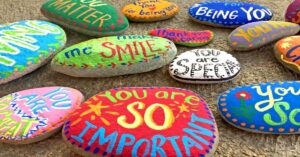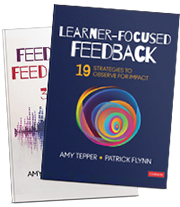Guest Author: Amy Tepper
Amy is a Senior Contributing Consultant with ReVision Learning Partnership
I recently reread the Voices of ReVision post Patrick wrote in January for the new year about goals. Did everyone catch that one? He’s a runner, and though I was Captain of the Cross Country team in high school and can relate to some of his challenges and triumphs, I choose a less punishing form of workout these days—yoga.
Because we love what we do, Patrick and I see lessons for our teachers and administrators in everything that we do—and yes, there I was in yoga yesterday having an epiphany about not just goals, but how we measure our own progress toward them. My ongoing goal: To not think of work in yoga. In the past 6 weeks, I’ve been immersed in Collegial Calibration sessions with administrators across the state specifically deconstructing and debriefing lessons related to the assessment indicators of the districts’ instructional frameworks. So here I am working on contortionist arm balances considering how students learn, thinking about how long it took me to get up in the elusive headstand a few years ago…and how I continue to learn and master certain skills that seem to be insurmountable challenges upon first introduction. How is it possible that I can accomplish these unbelievable feats?
I always have someone who I model or emulate who talks through the process and steps, outlining and demonstrating the various odd uses of limbs and of abs. I watch and try. I notice kicking your feet up wildly does not seem to be working. My teacher notices and mentions kicking your feet wildly will not work. I adjust. She adjusts her suggestions. I persevere. I triumph. What was at play to allow this to happen?
Of course, a combination of factors contributed to my success: a growth mindset (no disdain for those who can already do this and a definite willingness to look ridiculous in front of a group…), a positive environment, an understanding of what it looked like to be successful, self and teacher monitoring, adjustment and feedback. This sounds vaguely familiar. Hold on. Here I am in tree pose thinking these are all of the attributes of 3c on the CT Common Core of Teaching–how we have defined effective assessment cycles and support in our classrooms (3c.1).
I have asked my Collegial Calibration participants two key questions everyday, “Why do we need to present our students (or work with our students to create) criteria?” and “What exactly can be considered criteria?” We all arrive at the determination that if we are truly developing lifelong learners, we must share and ultimately turn over the learning to our students. Students can be guided in selecting or designing the best ways to demonstrate their own learning and determine related criteria. If we can show them what mastery looks like, they can learn to self-monitor and self-assess progress toward that goal. Ideally, we will do that for the rest of our lives as we work to accomplish tasks and challenges. This is all encompassed in one concise attribute or indicator on a framework, but has so much depth and infinite benefit for our students.
How, as teachers, can we show students what mastery looks like? The immediate answer I receive in my groups is “rubrics.” And when I read feedback provided to teachers, we are consistently telling them they need to have “rubrics.” We have to expand our thinking as instructional leaders and teachers around the fact that there are many ways to convey criteria to students. It would be downright weird and clearly not very Zen to stop and consider a rubric in yoga. Providing an example—an exemplar, a model through a think aloud or even a nonexample all fit this bill, especially for learning tasks that result in a performance or creation of a product. And what about checklists? In math, we encourage students to use strategies–the inverse operation or plug in a number for a variable. We are teaching them to ask themselves, “Does that make sense?” “How can I check myself?” Then, as we float and monitor, we can remind students in our feedback to use the tool, strategy or resource—building independence and consistently messaging a high expectation and a belief in our students’ ability to move forward.
As instructional leaders, we must realize as we coach and support our teachers in the area of assessment that there are many layers and interconnected factors that usually reside in planning. Assessment does not exist in isolation:
- Lessons need to be scaffolded and logically organized to advance students toward specific daily learning targets.
- Assessments need to be directly aligned to provide evidence of progress toward these targets.
- Teachers need to be able to define what that progress and mastery should look like.
- They need to create environments where students will take risks and persevere toward that mastery.
- We must teach our students HOW to use the criteria to monitor and move forward.
If our end goal is for students to self-assess, simply sharing the criteria with them is not enough. Last week, I watched a teacher model how to break down text with different colored markers into main idea (stated) in red, supporting details in blue and transitions in green. Students then followed along, developing an example that they could take into independent work. However, when observing them on their own, I heard a student ask her partner: “Does everything need to be in blue?” Her colored example was not effectively serving as a tool for a self-check. The tool was suitable, but the coaching point resided in the instructional strategies and scaffolding in the mini-lesson that led up to this moment.
As instructional leaders, it is important to engage with students to objectively and accurately determine the effectiveness of any practices. During classroom visits, we can ask students questions such as, “How do you know when you have it?” or “What should this look like or contain?” (ex. when working collaboratively or writing an essay comparing two texts) “How will you know you have the right answer?” (ex. when solving math problems or examining laws in science) or more specifically, “How are you using this checklist?” The answers provide the key for our feedback that will further increase the teacher’s impact and ability to build independence.
As students are given the opportunity to build independence through scaffolded supports and an understanding of how to effectively utilize resources and tools, they develop the ability to problem solve on their own. They become willing to take risks, grapple with complex ideas or tasks, think outside the box, and persevere. By encouraging these steps and building the capacity around them we are promoting a lifelong growth mindset and messaging everyday, “The journey is the reward.”
I have had to learn to embrace that mantra in yoga. I am now off to practice “side crow.” I am feeling good about this one. It is one of my favorites as, when I have it, I am in a pose resembling a 1980’s breakdancing stance.
Please feel free to respond to this post with various methods or tools you use or have observed in use in establishing criteria for students.





Leave a Reply